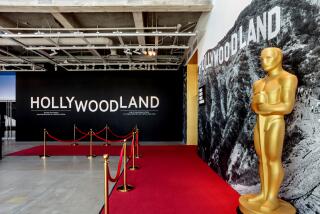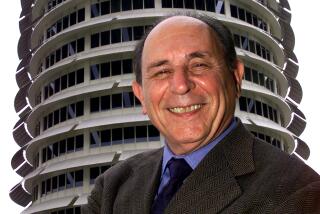Major Overhaul for Classic Car Lot
- Share via
Things seem to happen by chance at the corner of Olympic Boulevard and Hope Street in downtown Los Angeles.
It’s where in 1922 Packard automobile dealer Earle C. Anthony accidentally launched the city’s commercial broadcasting industry when he put a radio transmitter on his roof so he could talk to fellow car dealers in the state.
It’s where Anthony unintentionally sparked America’s electric sign advertising craze in 1923 by installing the country’s first neon sign on the wall outside of his showroom.
And it’s where pure happenstance led a Jewish immigrant from Iran to create a new housing project that is highlighting Anthony’s Los Angeles legacy for a generation that probably has never known of him or his car.
Developer Joseph Emrani has converted the long-abandoned Packard dealership into a hip new residential and retail project that pays homage to both the car man and his classically designed motor machine.
Emrani’s family fled Iran in 1980 after that country’s revolution. He said he had never heard of either Anthony or Packard when he and his brothers purchased the building with an eye toward redeveloping the property.
“I had no idea that this had a history. We knew it had been a car dealership in the past, but we didn’t know which one. We didn’t know all that Earle C. Anthony had accomplished. Then one day, right as we were starting construction, this gentleman came in.”
The visitor was Greg Fischer, a local historian and an aide to downtown-area City Councilwoman Jan Perry. He knew of the building’s past and he was curious about its future.
“They walked me through the whole building and explained what they were planning to do. I said, ‘I don’t think you know what this building was -- I don’t think you know what you have here,’ ” Fischer said.
He explained that Anthony had started KFI radio on the building’s roof. And that Anthony created a sensation by plugging in the nation’s first neon sign made from gas-filled glass tubes that he commissioned from a French chemist, Georges Claude.
Fischer returned with a folder full of old newspaper clippings that told of Anthony and of Packard and the pioneering events that had occurred at the sturdily built concrete building. “I said, ‘He’s the iconic, original L.A. transportation guy when it comes to the automobile.’ They got it right away,” Fischer said.
Emrani scrapped the name “L.A. Lofts” that he had planned to use for the $35-million redevelopment. Then he set out to find ways of commemorating Anthony and his classic motor car.
Wednesday night he unveiled the 116-unit rental project, called Packard Lofts. A fleet of vintage Packards once more filled the place as women dressed as Roaring ‘20s flappers milled about, admiring the cars’ polished chrome and plush leather interiors.
Packard collectors from around the country were there. So was one man who once ferried Packards up and down the dealership’s driveway ramps for Anthony himself.
Jim Padden’s father was Anthony’s service manager between 1919 and 1929. As a 14-year-old, Padden visited the dealership on Saturdays and moved cars around for mechanics.
“I’d drive them up the ramp to have their wheels straightened and their engines worked on. Everybody called the owner Mr. Anthony -- you never called him Earle,” said Padden, 81, of West Los Angeles. “My father always drove Packards. I came with him in 1934 when he traded in his old one for a new one he picked out right off Mr. Anthony’s showroom floor.”
Padden’s appearance Wednesday night was accidental, too. It turns out that Fischer’s mother once dated Padden. She insisted that Fischer wrangle an invitation for him to attend the loft project’s opening.
Packard owner Bob Knee of West Hollywood was also there, along with his shiny sedan that rolled out of Anthony’s dealership in 1927. “I still have its original dash badge. So I know it was purchased at Earle C. Anthony’s,” Knee said.
Stuart Blond, a Packard aficionado who edits the Packard Cormorant Magazine, read by serious collectors, traveled from his Fords, N.J., home for the event. He explained that Anthony had built his rooftop station so he could communicate with other Packard agencies in California that he controlled.
“Then radio exploded and he was running advertising for his cars and for others as well. He had twin broadcasting towers on the roof here that had ‘KFI Packard’ signs on them. He ended up making more money from broadcasting than selling cars,” Blond said.
The Olympic and Hope dealership sold Lincoln and Mercury cars after Packard, which had been absorbed by Studebaker, went out of business in the late 1950s. The building was used for a time as a bank after the last cars were sold there in 1962.
Many of the vintage cars driven downtown Wednesday were from the American Driving Museum in West Los Angeles. Museum curator Earl Rubenstein said he bought his first car -- a year-old 1955 Packard -- from Anthony, only to have his father order him to return it the next day.
“My dad said it was too expensive for me to drive. So I brought it back and got a ’48 Pontiac. I wasn’t happy about that. But at least I had wheels,” Rubenstein said.
Rubenstein said he was invited to take his collection of Packards downtown Wednesday after Emrani happened to spot one of them while driving past the museum.
“It was purely coincidental that he stopped in,” Rubenstein said. “I’m delighted they’re doing this. It’s not just the Packard legacy that is important, but what Earle C. Anthony did for this city.”
Perry was appreciative of Emrani’s efforts. “Unfortunately, we’ve lost a lot of iconic structures in Los Angeles. This is an historic space,” the councilwoman said.
Emrani said permanent displays and artifacts in his building will trace that legacy. And a replica of Anthony’s first neon sign has been commissioned from a local sign maker.
When it’s finished, the Packard glow will again light up the corner of Olympic and Hope.







